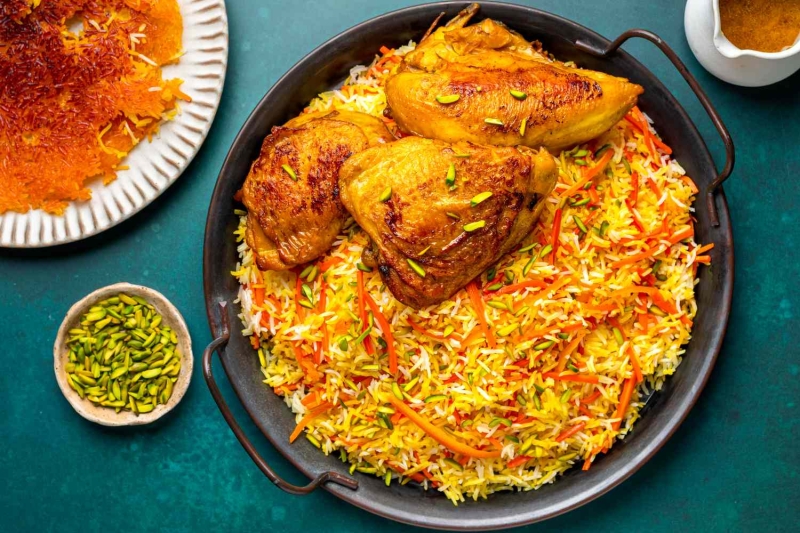Carrot and Rice Pilaf with Braised Saffron Chicken
Prep: 20 mins
Cook: 90 mins
Total: 110 mins
Servings: 4 Servings
Yield: 8 Cups
In the world of Persian rice, the cooking methods range from simple to complex, and the texture varies from light and fluffy to crispy and crunchy—all in the same dish!
At first glance, you will notice the long list of ingredients and steps for Havij Polow, accounting for the depth and complexity of its flavors. However, I do hope that won’t deter you from giving this recipe a try, as just about every ingredient is readily available without a trip to a specialty store.
What makes Havij Polow so distinctive is the delicate combination of ingredients that creates a highly flavorful, mildly sweet, and aromatic dish. Lightly sautéed carrots are mixed with fragrant candied orange and tossed with bloomed saffron. The result is, well, self-evident; a colorful and vibrant dish that is bound to be a visual and gastronomic hit on your table!
Rice In Persian Cuisine
Rice, or polow in Farsi, is the primary grain consumed in Persian cuisine and is served for lunch or dinner, or often both. Dozens of varieties of rice are cultivated in northern Iran by the Caspian Sea, but Basmati rice tends to be a favorite for Iranians, particularly those living outside of Iran.
Basmati is a long-grain rice that is intoxicatingly fragrant with a nutty flavor. With a little bit of effort it can be made exceptionally light and fluffy; the two words that have become synonymous with Persian rice.
Making Persian Rice
Persians have mastered the art of cooking rice and have taken it to a whole different level. Rice is first soaked to release some of its natural starch and then parboiled, rinsed, and steamed to create the desired fluffy texture. The placement of a clean towel underneath the lid of the pot allows for the steam to be captured, ensuring the proper cooking of the rice.
An Introduction to Tahdig
A mention of Persian rice is never complete without reference to Tahdig. In Farsi, Tah means bottom, and Dig means pot, so this word refers to the layer of rice that becomes crispy and crunchy on the bottom of the pot, creating a wonderful contrast to the fluffy rice above. Tahdig comes to life and is cooked to crispy perfection with the addition of oil and saffron.
How to Serve Persian Rice and Tahdig
Persian rice is often served upside down, much like an upside-down pineapple cake, to showcase this beautiful and enticing saffron-colored Tahdig that encloses the fluffy rice. The inversion process does, however, require a nonstick pot. If using a regular pot, the fluffy rice is first removed with a large spatula, and then large chunks of Tahdig are removed separately.
At first glance, you will notice the long list of ingredients and steps for Havij Polow, accounting for the depth and complexity of its flavors. However, I do hope that won’t deter you from giving this recipe a try, as just about every ingredient is readily available without a trip to a specialty store.
What makes Havij Polow so distinctive is the delicate combination of ingredients that creates a highly flavorful, mildly sweet, and aromatic dish. Lightly sautéed carrots are mixed with fragrant candied orange and tossed with bloomed saffron. The result is, well, self-evident; a colorful and vibrant dish that is bound to be a visual and gastronomic hit on your table!
“Havij Polow is the ultimate combination of Persian flavors. It’s super aromatic and I loved how the Tahdig turned out so golden and crispy. The orange gives the rice elegance and the slivered pistachios add crunch. When serving, you can serve the leftover chicken broth in a small bowl to pour over the rice for more flavor.” —Bahareh Niati
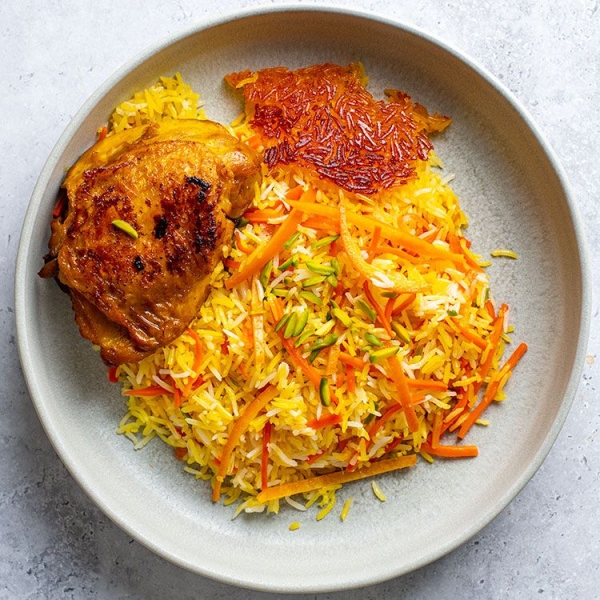
A Note From Our Recipe Tester
Ingredients
For the Saffron Water
-
1 heaping teaspoon saffron threads
-
8 tablespoons lukewarm water
For the Chicken
-
1 tablespoon neutral oil, such as canola or vegetable
-
4 medium pieces bone-in, skin-on chicken, such as thighs and breasts
-
1 large onion, diced
-
1 teaspoon turmeric
-
2/3 cup water, more as needed
-
1 teaspoon fine salt
-
1/2 teaspoon ground black pepper
For the Candied Orange
-
1 navel orange
-
1/2 cup water
-
1/2 cup sugar
For the Carrots
-
2 tablespoons neutral oil
-
4 medium carrots, cut into matchsticks (about 2 cups)
For the Rice
-
10 cups water
-
2 tablespoons fine salt, for parboiling rice and will be rinsed out
-
2 cups white basmati rice, soaked for 1 hour and rinsed
-
2 tablespoons neutral oil
-
1/4 cup slivered or chopped pistachios, for garnish
Steps to Make It
Prepare the Saffron Water
-
Gather the ingredients.
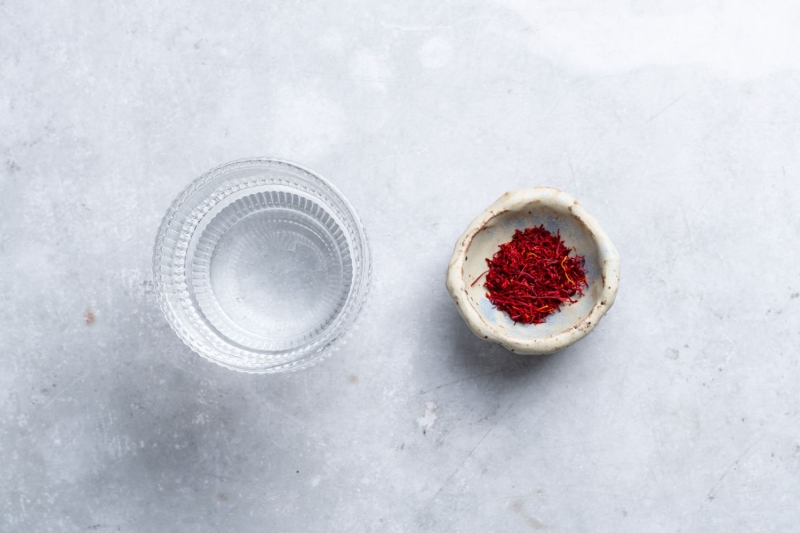
-
Using a smooth mortar and pestle, grind the saffron threads finely, add water, stir and set aside.
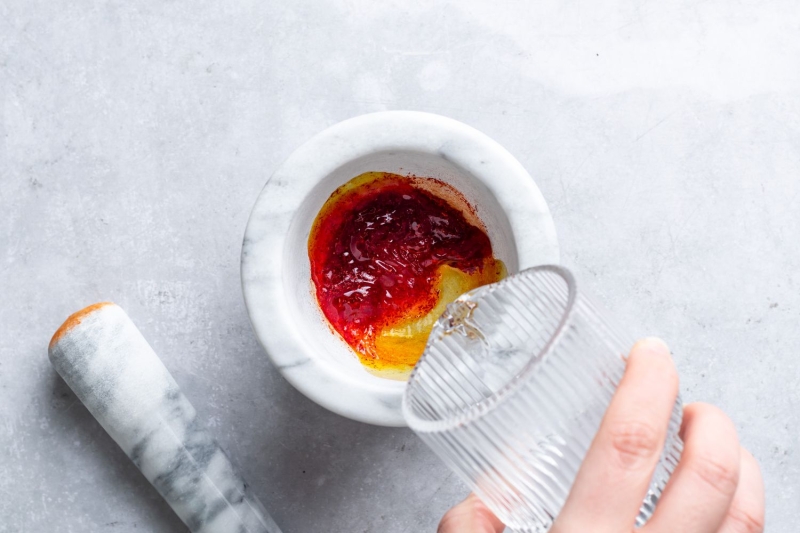
Prepare the Chicken
-
Gather the ingredients.

-
Add the oil to a large skillet over medium-high heat. When the oil shimmers, add the chicken and sauté for 5 minutes on each side. Remove the chicken pieces from the skillet and set aside.
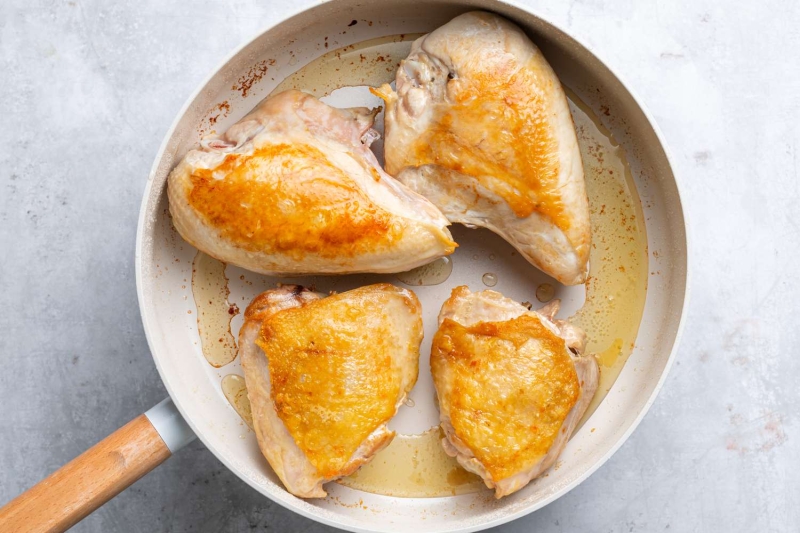
-
Add the onions to the same skillet and sauté over medium heat until translucent and lightly golden, about 5 minutes.
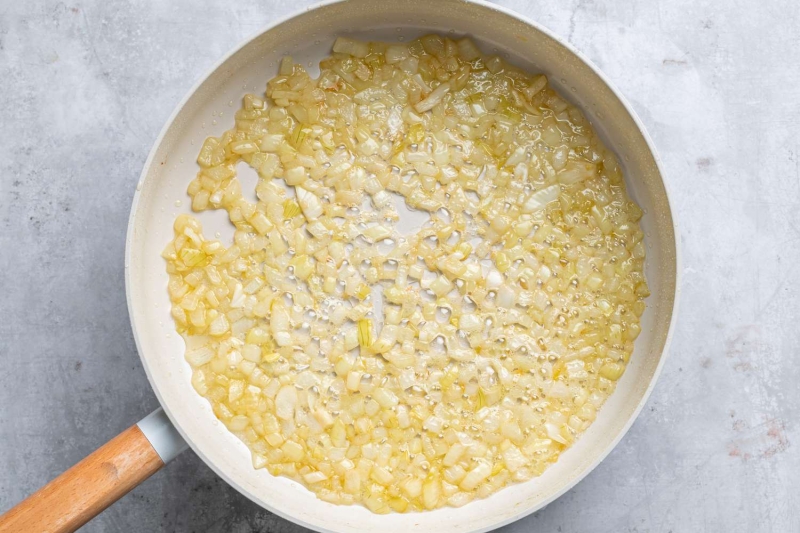
-
Add turmeric and sauté, about 1 minute.
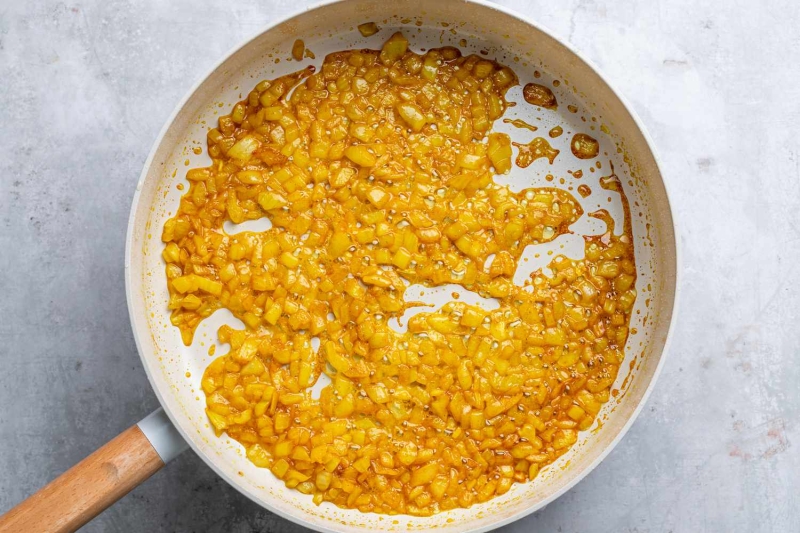
-
Return the chicken to the skillet, add the water, salt, and pepper, and stir.

-
Cover and simmer the chicken over low heat until completely tender, 1 1/4 to 1 1/2 hours. Be sure to turn the chicken over halfway through cooking and check the liquid level. Add a small amount of water if the liquid level has reduced to less than 1/2 cup.
Meanwhile, as the chicken cooks, prepare the candied orange zest, carrots, and rice.
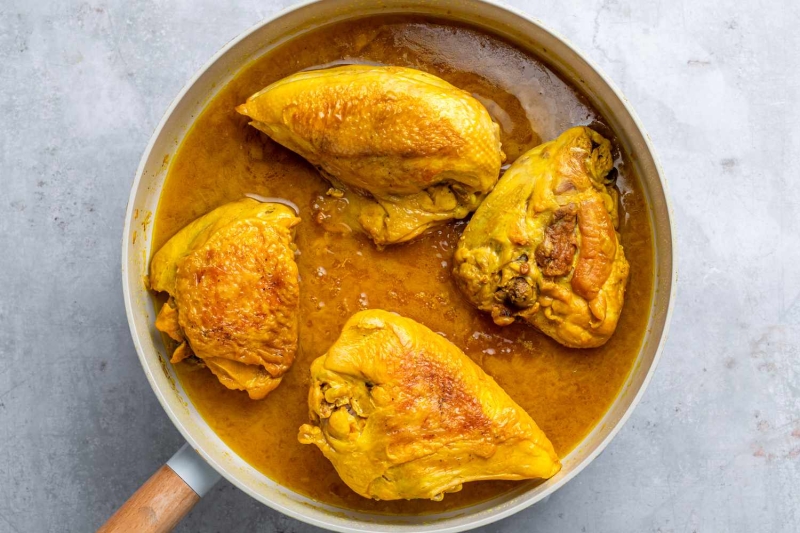
-
When the chicken is tender, add 3 tablespoons of saffron water, simmer for a further 5 minutes, and remove from heat. Set aside.
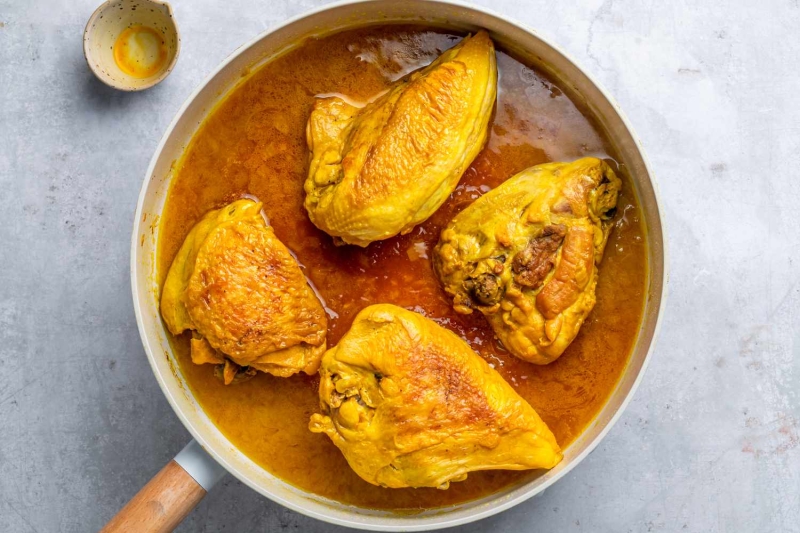
Prepare the Candied Orange Zest
-
Gather the ingredients.
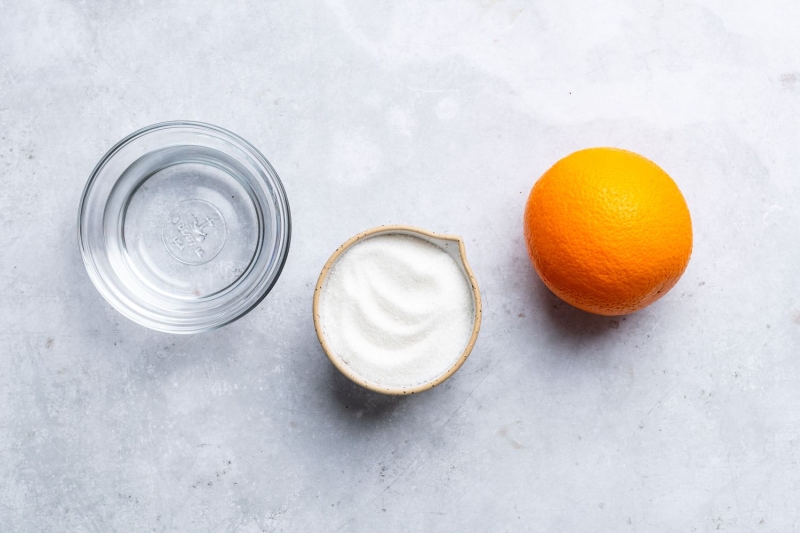
-
Score the navel orange into quarters with a paring knife, approximately 1/8 inch deep. Peel the orange and remove as much of the white pith as possible. Thinly slice the orange peel into matchsticks.
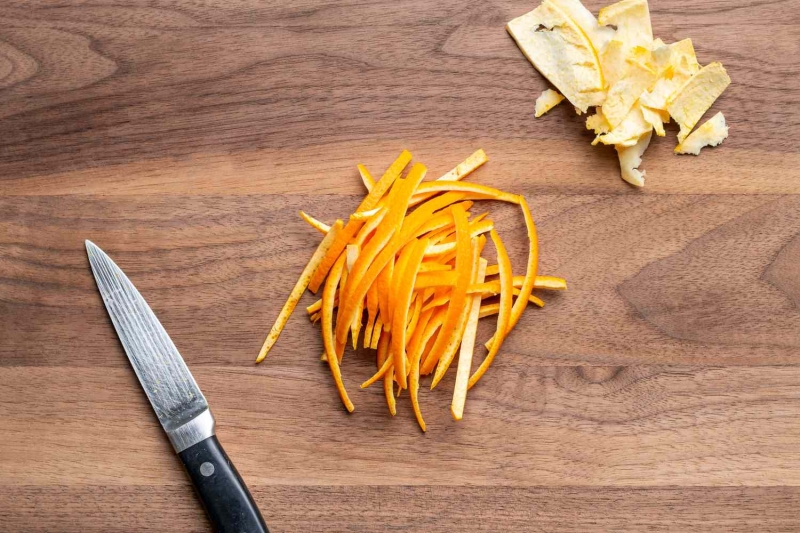
-
Place the orange peel in a small saucepan with the water and sugar. Stir and bring to a gentle boil over medium heat. Lower the heat to medium-low, and continue to simmer, uncovered, until 3 to 4 tablespoons of syrup remain in the pot, about 15 minutes. Set aside.
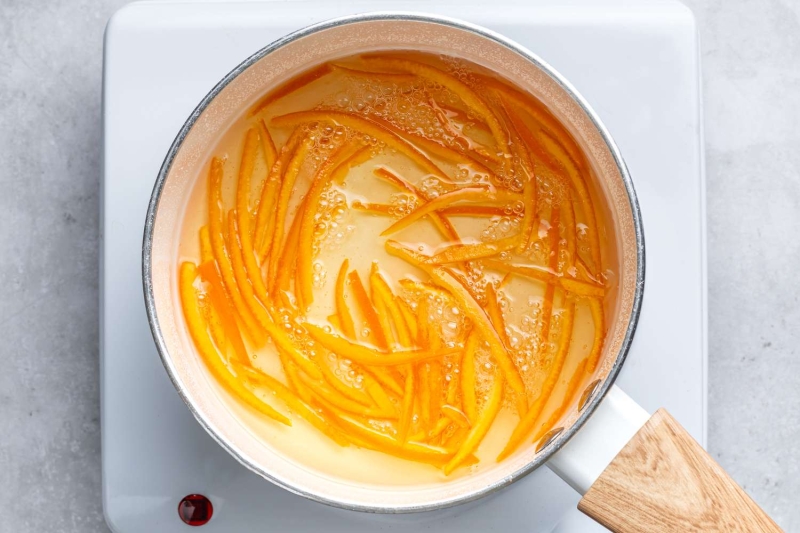
Prepare the Carrots
-
Gather the ingredients.
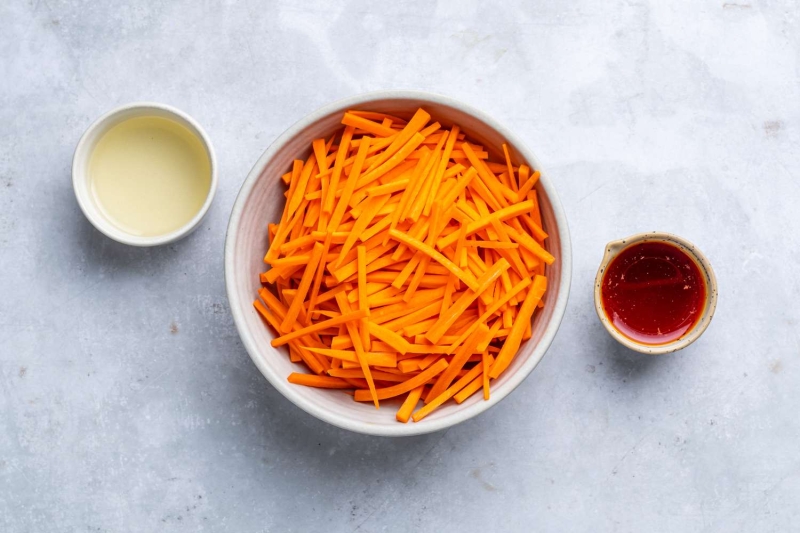
-
Heat the oil over medium heat in a medium skillet. Sauté the carrots until crisp-tender, about 2 minutes. Avoid cooking the carrots until soft at this stage because they will be steamed further with the rice.
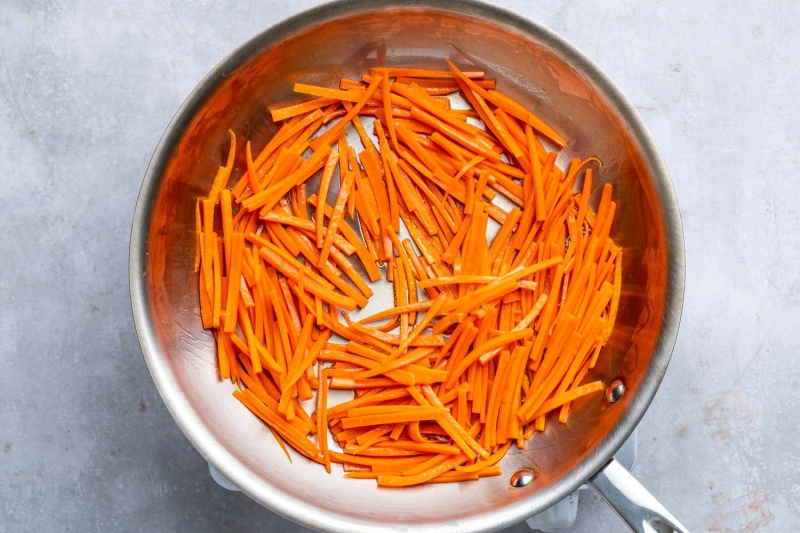
-
Add the candied orange peel and syrup, and 3 tablespoons of reserved saffron water. Cook for 1 minute. Remove from heat and set aside.

Prepare the Rice and Serve
-
Gather the ingredients and pistachio garnish.
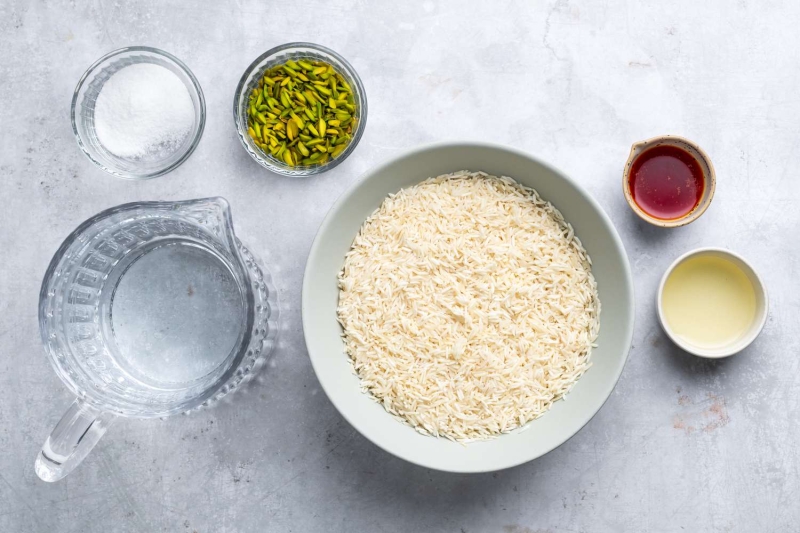
-
In a large, covered pot, bring the water and salt to a boil on high heat. Once boiling, add the rinsed rice and bring it back to a boil. Cook until the rice is al dente, 5 to 10 minutes (cooking times will differ depending on the type of rice, so start checking early).
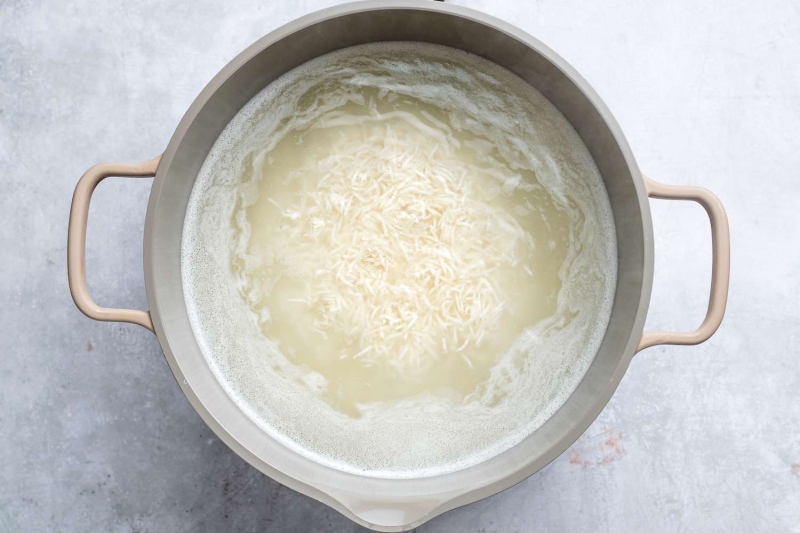
-
Drain the rice in a colander, rinse with warm water, and set it aside while you prepare the pan for the next stage of cooking.
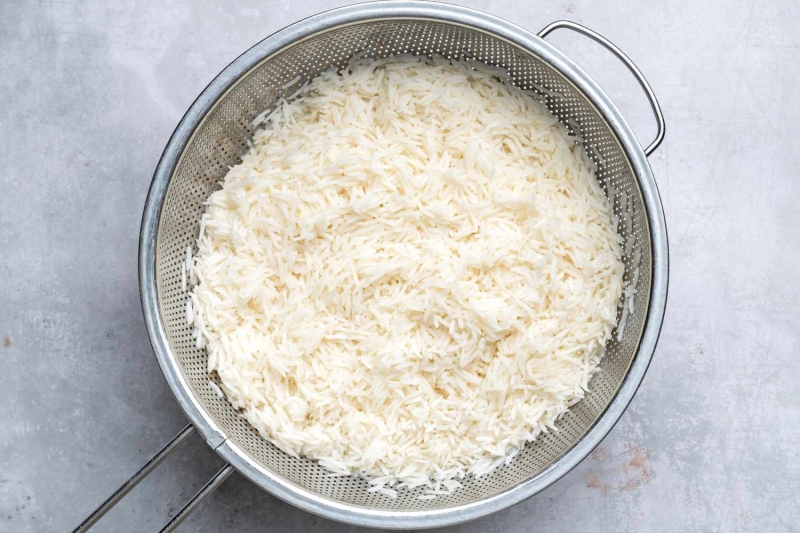
-
Mix 1 cup of the parboiled rice gently with 2 tablespoons of reserved saffron water in a small bowl,
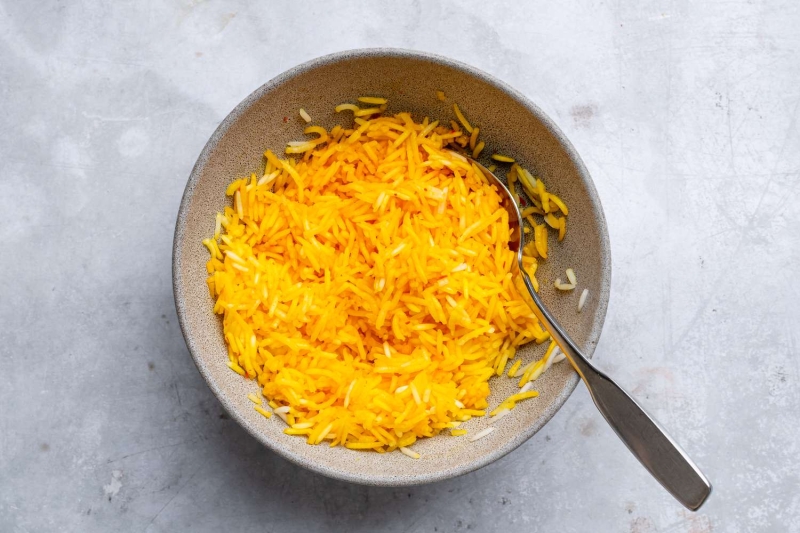
-
Add the oil to a medium non-stick saucepan, spreading it around the base of the pot. Spread the saffron-rice mixture evenly over the bottom of the pot. This will be the crispy rice referred to as Tahdig.
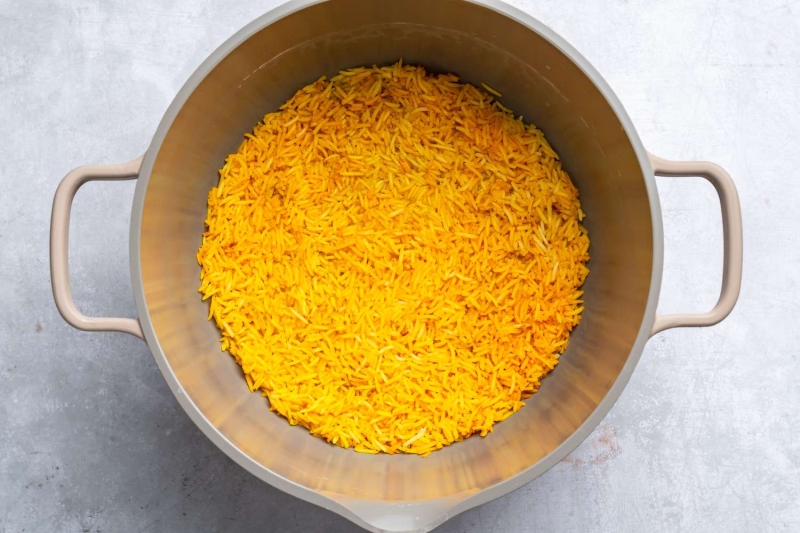
-
Layer 1/3 of the partially cooked rice into the pot, and cover with 1/3 of the carrot mixture. Repeat until all the rice and carrots have been layered in the pot. Gently stir the rice mixture with a fork to combine leaving the bottom layer undisturbed.
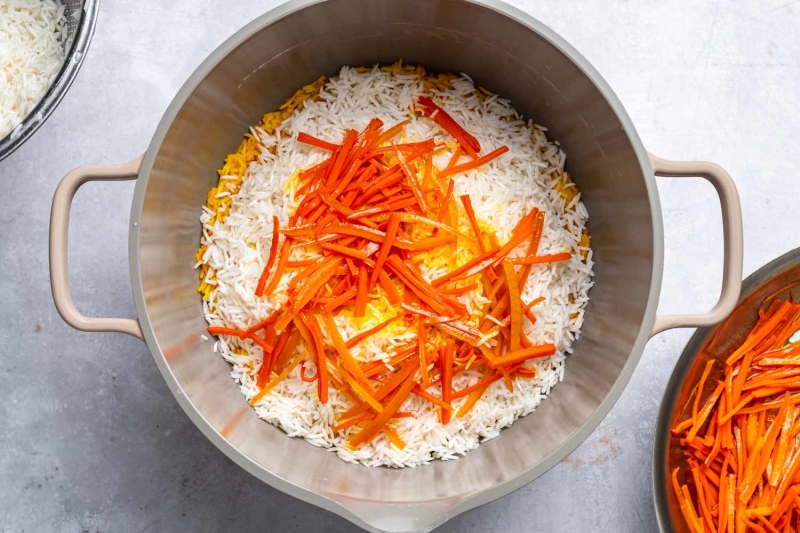
-
Wrap the lid of the pot with a small clean kitchen towel and cover the pot. Be sure to pull the towel edges away from the heat, and if possible tie the corners in a knot on top of the lid. Steam the rice over medium-low heat until the rice is crispy and brown on the bottom, 40 to 45 minutes. Remove the pan from the heat and allow to rest for 5 minutes, still covered.
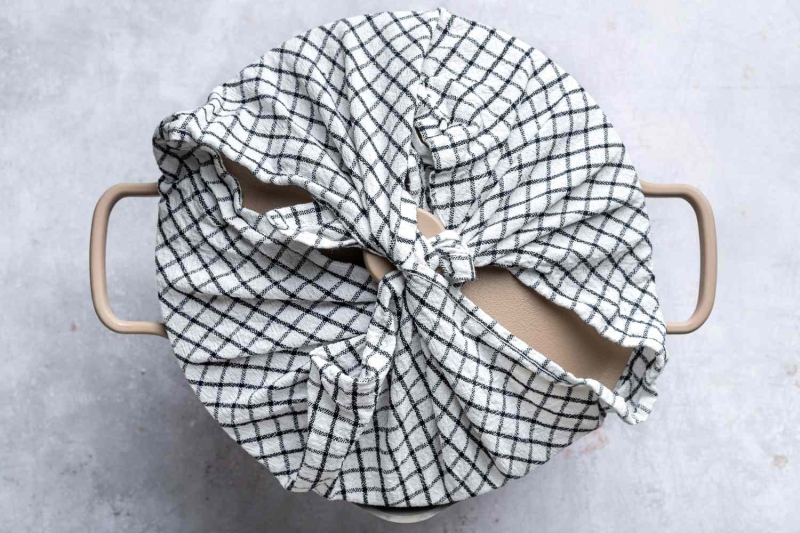
-
Select a plate or platter that is larger than the pot. Remove the lid of the pot, and place the plate upside down on top of the pot. Carefully and swiftly invert the rice onto the platter (the Tadig should release from the bottom of the pot).
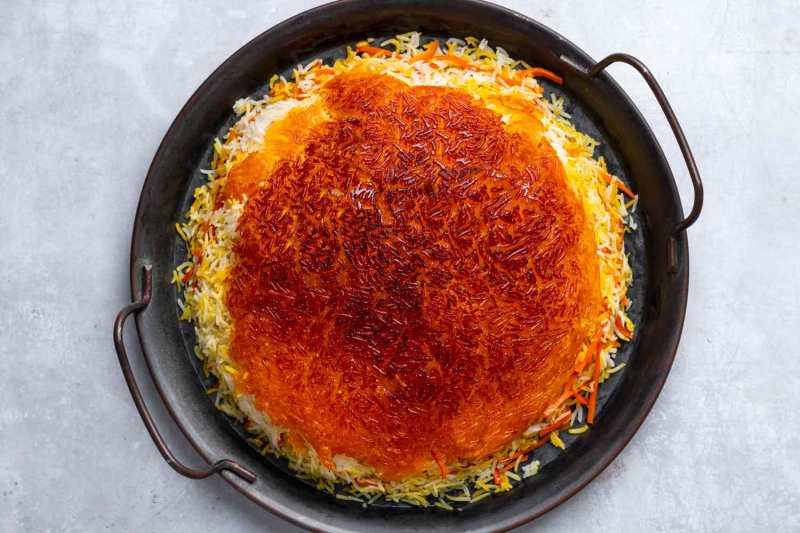
-
Serve the chicken on top of the Tadig, or you can remove the fluffy rice from the pot, top with the chicken, and serve the crispy Tadig on a separate plate. Garnish with pistachios and serve.
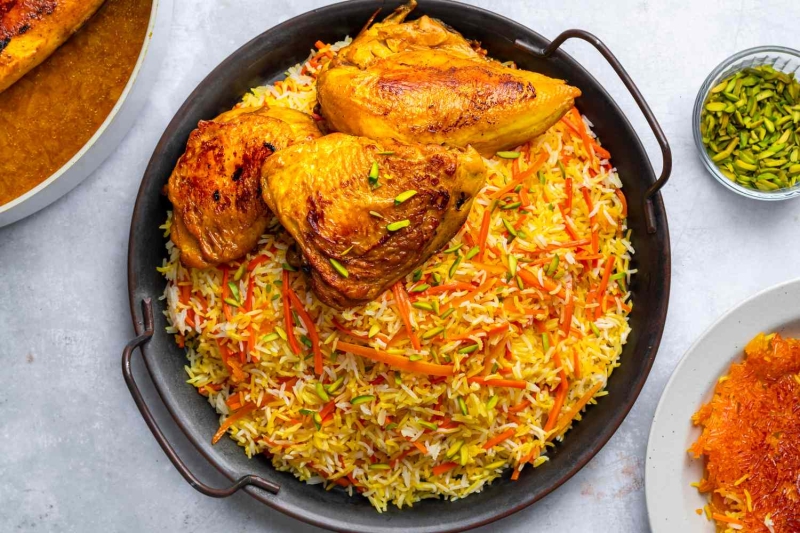
Recipe Tips
- To save some time, pre-julienned carrots can be purchased.
- The candied orange can be replaced by a commercially prepared jar of orange marmalade.
- Candied oranges can be prepared up to a week ahead, and kept in the refrigerator.
- Julienned carrots can be sauteed up to 2 days ahead and kept in the fridge.
Recipe Variations
- Havij Polow can be served with braised beef or lamb.
- A store-bought or home-prepared roasted chicken can be a great substitute for the braised chicken.
Storage and Leftovers
Store the leftover rice and chicken in an airtight container in the refrigerator for up to 4 days or in the freezer for up to 1 month. Reheat in a skillet over medium-low heat, adding a small amount of water to properly hydrate the rice and bring it back to life.
| Nutrition Facts | |
|---|---|
| Servings: 4 | |
| Amount per serving | |
| Calories | 917 |
| % Daily Value* | |
| Total Fat 41g | 53% |
| Saturated Fat 8g | 41% |
| Cholesterol 208mg | 69% |
| Sodium 1350mg | 59% |
| Total Carbohydrate 100g | 36% |
| Dietary Fiber 11g | 38% |
| Total Sugars 57g | |
| Protein 46g | |
| Vitamin C 188mg | 938% |
| Calcium 210mg | 16% |
| Iron 4mg | 23% |
| Potassium 1291mg | 27% |
| *The % Daily Value (DV) tells you how much a nutrient in a food serving contributes to a daily diet. 2,000 calories a day is used for general nutrition advice. | |
